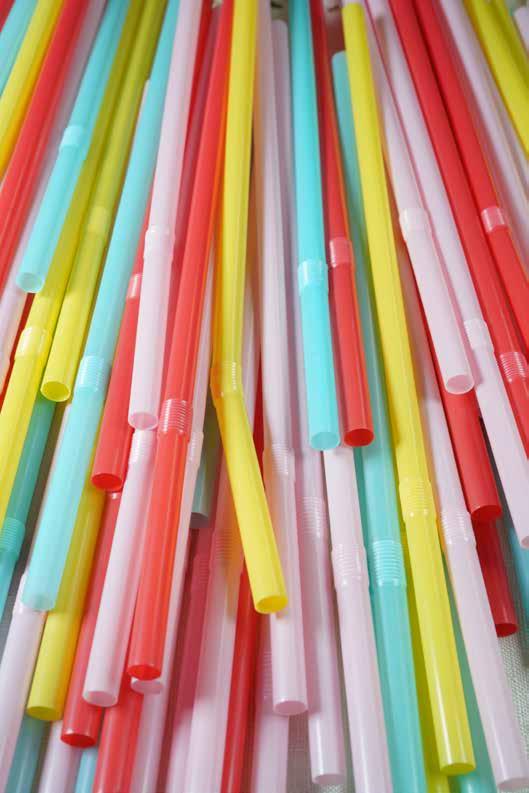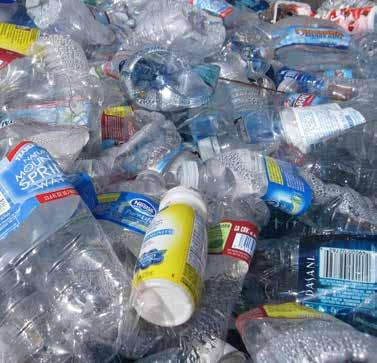Strengthening Sustainability in the Plastics Industry



About IFC
IFC—a member of the World Bank Group—is the largest global development institution focused on the private sector in emerging markets. We work in more than 100 countries, using our capital, expertise, and influence to create markets and opportunities in developing countries. In fiscal year 2020, we invested $22 billion in private companies and financial institutions in developing countries, leveraging the power of the private sector to end extreme poverty and boost shared prosperity. For more information, visit www.ifc.org.
Authors
This report was written by IFC Manufacturing, Agribusiness & Services (MAS) staff members Juan Villar Mallagray, Investment Analyst; Samu Salo, Senior Industry Specialist; Li Tu, Global Sector Lead and Senior Investment Officer; and Sabine Schlorke, Global Manager. For additional information about this report, please contact Li Tu at ltu@ifc.org.
Acknowledgments
Special thanks to Gary Seidman and Kathy Chen for their involvement in producing this series. In addition, Irina Sarchenko, IFC Communications Analyst managed the design process, and Aliza Marcus, IFC Senior Communications Officer for Manufacturing, Agribusiness & Services, assisted in the preparation and finalization.
Disclaimer
The findings, interpretations, views, and conclusions expressed herein are those of the authors and do not necessarily reflect the views of the Executive Directors of IFC or of the World Bank or the governments they represent. While IFC believes that the information provided is accurate, the information is provided on a strictly “as-is” basis, without assurance or representation of any kind. IFC may not require all or any of the described practices in its own investments, and in its sole discretion may not agree to finance or assist companies or projects that adhere to those practices. Any such practices or proposed practices would be evaluated by IFC on a case-by-case basis with due regard for the particular circumstances of the project.
Rights and Permissions
© International Finance Corporation 2020. All rights reserved. The material in this work is copyrighted. Copying and/or transmitting portions or all of this work without permission may be a violation of applicable law.
Growing global concerns over climate change are putting an increasing focus on sustainability. This report is part of an occasional series on sustainability in industry which examines the opportunities and challenges facing various industrial sectors and the role that the International Finance Corporation can play to support their efforts and contribute to a greener planet.
Plastic is indispensable to modern life, so ubiquitous that it is virtually invisible. In many ways, it is an ideal material. Invented in the mid-19th century, plastic is remarkably versatile and relatively cheap to make, and it can be used as an inexpensive substitute for wood, glass, metal, and many other building and manufacturing materials.
On average, plastic constitutes about 15 percent of a car’s total materials by weight, a quarter of a smartphone’s weight, and half of an airplane.

Plastics are the building blocks of many value chains, including packaging, health care, construction, aviation, logistics, clothing, and increasingly, the recycling industry. They play a vital role in driving industrial development, creating jobs, expanding opportunities, and generating wealth to improve people’s lives. But as the use of plastic has increased, so too have the environmental and social costs. The production process uses petrochemicals as a raw material and generates greenhouse gas emissions. Perhaps the biggest cost is the waste generated by discarded plastic goods. Most of the
common plastics of today are not fully biodegradable, and that has created a cascade of environmental, financial, and health problems around the world. Every year, eight million tons of discarded plastics make their way into the oceans.1 With enhanced recycling systems and better cooperation among industry, governments, and consumers, these plastics can be readily collected, reused, and turned into something of value. While companies and governments have made some inroads, innovations and commitments are needed to deal with plastic more holistically. In the past dozen years, the plastics industry has been urged to rethink the material’s entire lifecycle by developing manufacturing processes that use fewer natural resources, emit
less harmful gases, and create products that never end up as waste. At the same time, as public awareness of global warming has expanded and economic models that are kinder to the environment have emerged, consumers have shifted attitudes towards reusing, recycling, repairing, and sharing products.
Sector Background
Modern plastic first emerged in the mid-1800s with the invention of celluloid and polyvinyl chloride (PVC), initially used to make billiard balls.2 The material’s breakthrough came in 1907 when Belgian-American chemist Leo Baekeland developed a synthetic, durable, mass-produced material that he called Bakelite, which was used to make jewelry and later telephones.3 Today, the plastics industry is one of the largest manufacturing industries in the world, producing plastics out of natural gas, oil, and plant products that are refined and combined to create polymers. Polyethylene, which is widely used to make bags, bottles, and films, is the most common plastic today and accounts for a third of the plastics market.
Plastic is not only cheap to produce but it also provides many modern conveniences that simultaneously benefit the environment. Plastic
With support from the International Finance Corporation (IFC) and the private sector, the industry is embracing initiatives and investing in novel technologies that can reduce plastic’s environmental footprint and provide broad economic benefits while meeting the growing demand for products made of plastic.
packaging keeps food fresher, decreasing food waste. It reduces the weight of automobiles, which lowers fuel consumption and greenhouse gas emissions. Plastic pipes deliver fresh drinking water and sanitation and hygiene services to communities. And plastic is part of every major value chain from clothing to medical devices to building materials to shipping to food and beverages.
Plastic’s broad application has helped to fuel rocketing demand over the past few decades. Global production totaled 368 million metric tons in 2019, compared with just 1.5 million tons in 1950.4 China is the biggest manufacturer, accounting for 29 percent of production, followed by Europe and the United States.5 The world’s largest plastic manufacturers include U.S.-based Dow Chemical, China’s Sinopec, and Saudi Arabia’s SABIC. According to the Plastics Industry Association, a U.S. trade group, the U.S.
plastics industry directly employs 993,000 workers.6
Demand and production are expected to continue to surge amid global increases in population and prosperity, with the International Energy Agency (IEA) estimating that plastic production will grow to 540 million metric tons a year by 2040. Demand for plastic has outpaced that for all other bulk materials, including steel, aluminum, and cement, since the turn of the millennium. Major players in the oil industry predict that demand for plastics will continue to increase exponentially in the coming decades, according to CMCC, an Italy-based research center focusing on climate change and policies.7 It says this trend
will result in the consumption of greater percentages of available oil, thwarting global efforts to limit greenhouse gas emissions and complicating attempts to manage waste. Thus, even as electrification is expected to stall or decrease demand for the crude oilderived fuel used for transport, the relative share of crude oil used for plastic production will continue to increase.
These trends, combined with more stringent government regulation and growing consumer concern, are pressuring plastic manufacturers and downstream consumers to change their approaches to production, use, and reuse of the material.
27
Sustainability
In recent years, attention has turned to circular economy models to reimagine better ways to manufacture and use plastic; systemize approaches for collecting plastic that has outlived
- Reduce the amount of plastic used
47
59
3
42
65
its productive life; and develop more effective ways to recycle and regenerate waste. The central concept of a plastic circular economy is to reduce, reuse, recycle, and redesign. This means:
- Reuse and extend the productive life of plastic products
- Recycle discarded plastic to create feedstock for new products
- Redesign plastic value chains and consumer behaviors to diminish waste
Plastics manufacturers and their end users have started to incorporate these concepts to become more sustainable.
Reduce
Businesses and governments have increasingly recognized the fundamental need to reduce the volume of plastic on the planet. In many countries, policy makers have introduced legislation that restricts or bans single-use plastic bags, mandates increased use of recycled materials, and incentivizes companies and consumers to use less and substitute more. Companies have taken steps to curtail the use of plastic by making lighterweight PET bottles, for example. PET is the lightweight plastic commonly used in packaging food and beverages. The website for Interpack, an international
packaging fair, describes a new PET bottle that “uses about one-third less material than the lightest bottle that is currently on the market.” ⁸,⁹ The benefits of reducing the use of plastic extend far beyond landfills and will have a meaningful impact on the volume of natural resources extracted from the earth and amount of greenhouse gases emitted in the production of the material.
1 4 2 5 3 6
Reuse
The outdoor clothing manufacturer Patagonia has launched the Worn Wear line as a place to buy used gear—a reuse concept right out of the Ellen MacArthur Foundation’s circular economy playbook.10 According to the company, keeping its clothing in use an additional nine months reduces the related water, waste, and carbon footprints by 20
Recycle
Recycling, a key component of circularity, focuses on collecting plastic waste for reprocessing and reuse. Darrel Collier, executive director of the National Association for PET Container Resources (NAPCOR), a U.S. trade group, says U.S. PET recycling capacity has been growing over the past decade but not fast enough to keep up with PET production even as manufacturers’ demand for recycled PET (rPET) increases. That has led to efforts to shore up recycling infrastructure. Coca-Cola, Keurig Dr Pepper, and PepsiCo, the U.S.’s biggest beverage companies, have committed to a 10-year investment program called Every Bottle Back, which seeks to modernize recycling infrastructure and educate consumers,
percent to 30 percent each. Patagonia also uses recycled soda bottles to make polyester thread. The luxury designer Gucci, meanwhile, uses a 100-percent regenerated nylon yarn called ECONYL that is derived from recycled fishing nets to make men’s outerwear.11 The clothing is part of its Off the Grid circular production initiative.
including through nationwide television commercials.12
Several virgin plastic resin manufacturers have acquired recycling processors and are developing blended product portfolios using both recycled waste and virgin resin. Last November, IFC extended a $300 million loan to Indorama Ventures Public Company Limited, a leading global manufacturer of virgin PET, to expand the company’s recycling capacity.13 By 2025, Indorama Ventures expects to be producing a minimum of 750,000 metric tons of rPET.
Redesign
To date, more than 400 global brands have begun to switch to reusable, recyclable, or compostable packaging for their products. In February 2021, CocaCola announced plans to debut a bottle in the United States that is made fully from rPET except for the label and cap. Unilever, the multinational consumer goods company, has introduced reusable containers for products such as deodorant and is making ultraconcentrated shampoos that provide the same number of uses in a container
made of half the volume of plastic.14 Ultimately, to achieve greater circularity, both business and consumer behaviors will need to change. Manufacturers have built their businesses and generate their revenues by making and selling new products, not servicing and repairing old ones. But shared economy businesses like Uber for cars and Mobike for bicycles are changing attitudes about ownership by offering convenient and affordable alternatives while squeezing more productive hours out of products.
Challenges & Opportunities
The most pressing concern facing the plastics industry is how to get rid of all the waste that has piled up and how to prevent future accumulation. Much of that waste is single-use plastic products such as bags and bottles that over decades fragment into microscopic particles that can harm wildlife and seep into the food chain. Plastic packaging alone accounts for almost half of the waste. The problem has intensified with the rise of online shopping, the popularity of bottled waters, and most recently, the widespread use of personal protective equipment such as face masks amid the COVID-19 pandemic. Without a better end-of-life strategy, the volume of plastic waste is estimated to double in the next 20 years and the amount finding its way into the world’s oceans will rise fourfold.
At the same time, regulators have become more assertive, using a combination of fines, taxes, and incentives to cajole the industry into becoming better environmental stewards. In 2019, the European Union adopted legislation that requires countries to ban some single-use plastics, reduce the use of others, and ensure that plastic producers take more responsibility for managing waste.15 In the U.S., at least 16 states have enacted legislation aimed at curbing plastic waste and encouraging greater use of recycled materials. Efforts are underway from Chile to India to reduce the use of plastic bags. Thailand banned single-use bags in 2020. Recycling currently offers the best solution to tackle plastic waste, but the
BOX I: COVID-19 Impact on the Plastics Industry
As the COVID-19 virus raced around the globe in 2020, it seemed that the pandemic might offer an environmental silver lining. Global carbon dioxide emissions fell by 6.4 percent, or 2.3 billion tons, in 2020, as economic and social activities declined. But unprecedented demand for personal protective equipment (PPE) and a drop in oil prices—making virgin plastic cheaper—financially benefitted plastic manufacturers. In its 4th quarter earnings report in January 2021, 3M, one of the world’s largest N95 facemask makers, reported that it sold 2 billion respirators during 2020 and had expanded production capacity to 2.5 billion masks.a N95 masks are made from synthetic plastic fibers, including polypropylene.b Health care workers and regular citizens were estimated to be going through billions of face masks every month as well as gloves, gowns, and other PPE with no system for collecting and disposing of them properly.c
In June 2020, Antonis Mavropoulos of the International Solid Waste Association, which represents recycling bodies in 102 countries, told The Economist that “consumption of single-use plastic may have grown by 250–300 percent in America since the coronavirus took hold.”d Market research firm Grand View Research said the global market for disposable face masks was more than $74.9 billion in the first quarter of 2020.e
Collection of potentially recyclable materials declined during the first 10 months of the pandemic. Recyclers told Reuters in October 2020 that since the pandemic struck, business shrank by more than one-fifth in Europe, by half in parts of Asia, and by as much as 60 percent for some firms in the U.S.f That left plastic manufacturers scrambling for feedstock. Because of the limited availability of cargo containers and higher freight costs, importing recycled plastic also proved difficult. Meanwhile, a decline in petroleum prices due to decreasing numbers of people driving and flying and temporary closures of factories and offices led to increased production of virgin plastics, with an associated rise in greenhouse gas emissions. Towards the end of 2020, the markets began to right themselves and recyclers “reported high production rates, nearing 100 percent in some cases, in comparison to around 50–60 percent over the summer,” according to S&P Global Platts.g
recycling industry has not been able to keep up with the volume of plastic being discarded. The Ellen MacArthur Foundation says that “while improving recycling is crucial, we cannot recycle our way out of the plastic issues we currently face.”16 Estimates vary greatly, but it’s safe to say that 250 million metric tons of plastic waste is generated each year and only about 14 percent gets recycled. At the same time, crossborder transfers of waste for recycling have declined. China in 2018 ended such imports and took steps to increase its own recycling and reuse of plastics. In 2020, more than 180 nations agreed to strictly limit exports of plastic waste from richer countries to poorer ones under a framework known as the Basel Convention.17 As demand for recycled content increases, recycling capacity should rise and with it, the availability of recycled and reprocessed plastics. Investing in recycling facilities presents an opportunity for both developed and developing countries, and is a priority area for IFC.
The recent high demand for, and limited supply of, recycled plastics, combined with newly enacted plastic taxes, have pushed up prices. In January, S&P Global Platts Analytics predicted that higher grades of rPET will cost about $150 per metric ton more than virgin PET in the medium term.18 Many market participants will likely be willing to pay the premium because the alternative is a tax of 800 euros per metric ton on unrecycled plastic under a new EU plastics tax enacted on January 1, 2021. This shows how regulation can help to make recycled plastics a viable business with consumers willing to pay higher costs to support sustainability—a strategy that should be replicated globally.
Another major challenge facing the industry is reducing manufacturing emissions. If plastic production stays on its current trajectory, by 2030, greenhouse gas emissions from the sector could reach 1.34 billion tons per year, equivalent to the emissions produced by 300 new 500-megawatt
WHAT IS PLASTIC MADE OF?
You could divide it into three categories: fossil-based (oil or gas), renewable (organic, bio-based) and recycled. The vast majority is made from the first category, only a fraction the second, and when we talk about plastic packaging, about 2% is made from recycled plastics.
coal-fired power plants.19 The sector has such high emissions because more than 99 percent of plastics are initially made from natural gas and crude oil—typically cheaper than using recycled feedstock— and because production of most plastic generates greenhouse gas emissions. In a report published in September 2020, the London-based think tank ODI said plastic manufacturing currently consumes about 9 percent of global oil and 3 percent of natural gas, but by 2050, “could account for as much as 20 percent of total oil consumption” and greenhouse gas emissions from the
sector could increase threefold.20 If left unchecked, the report says, greenhouse gases emitted from the production and use of plastic could threaten the Paris Agreement goal of keeping temperatures from rising 1.5 degrees Celsius above preindustrial levels. This is another reason to promote the use of recycled and reprocessed plastic, which has a much lower carbon footprint than virgin plastic. Some life cycle assessments for recycled plastics cite an 80 percent reduction in greenhouse gas emissions compared to virgin plastics.
BOX II: Examples of IFC’s Work
IFC engaged with Austria’s Lenzing and Brazil’s Duratex to build up the wood-based textile fibers value chain as an alternative to synthetic fibers. Unlike synthetic fibers, wood-based fibers do not shed microplastics into the water when washed and lend themselves more easily to downcycling. IFC provided a $500 million financial package to fund the construction of a greenfield dissolving wood pulp plant in Brazil that uses technology to reduce CO2 emissions.
IFC supported Mexico’s Petstar to construct and operate a bottle-to-bottle plastic recycling facility that converts post-consumer PET bottles into food-grade rPET resin, reducing the volume of municipal solid waste and the consumption of virgin PET.
IFC developed an e-Waste Management Advisory Program in India in partnership with the Nationwide Producer Responsibility Organization (PRO) to establish e-waste recycling ecosystems in all 29 states by: (i) integrating informal waste pickers and aggregators into the e-waste supply chain; (ii) addressing hazardous conditions by diverting waste to certified recyclers; and (iii) using mobile technology for transparency and accountability. Some 4,000 tons of e-waste were collected under the program to help producers meet compliance obligations.

